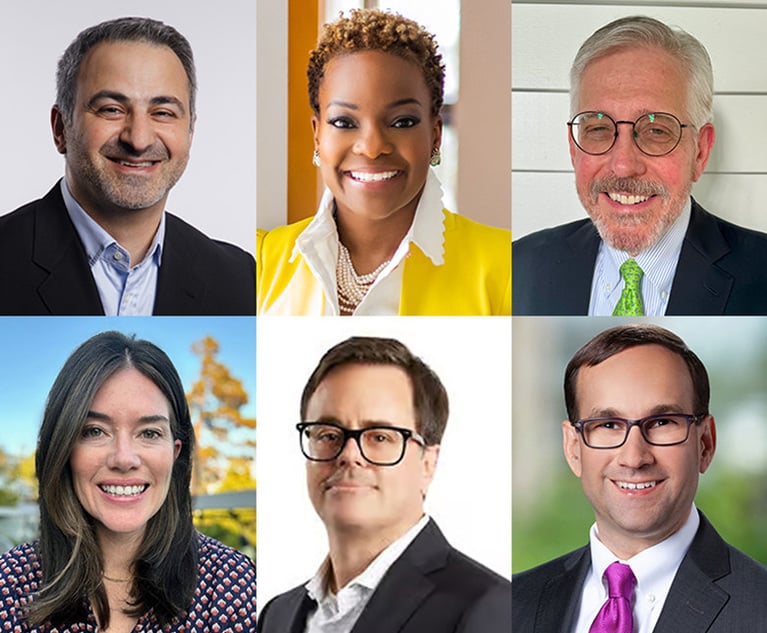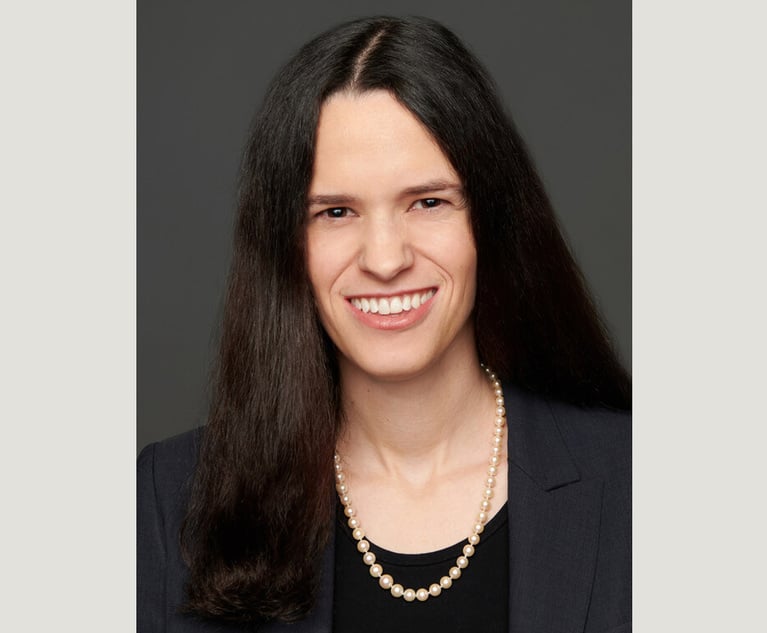Libraries win in Google Books infringement suit
Judge says libraries didn't infringe copyrights
December 20, 2012 at 07:00 PM
15 minute read
The facts may sound familiar. A group of major research libraries allowed Google Inc. to digitize millions of books in their collections. The digital copies were used to enable online searches of the books' contents. Then, The Authors Guild sued for copyright infringement.
This lawsuit, however, isn't against Google. Nor does it concern the Google Books project, Google's plan to enable users to search the text of millions of digitized books and then read relevant snippets from many copyrighted books.
The Authors Guild, Inc. v. HathiTrust is the obverse of the Google Books litigation. Instead of examining whether Google's use of digitized books was infringing, this case examines whether the libraries' use of digitized books was infringing. Did these libraries infringe when they allowed Google to digitize their book collections and then offered limited online access to the digital copies?
The answer is “no,” according to Federal District Court Judge Harold Baer. On Oct. 10, 2012, he granted summary judgment to the accused infringers, finding they had made fair use of the copyrighted books.
This decision could have a significant impact on the Google Books suit. “It's a strong precedent in Google's favor,” says James Grimmelmann, a professor at New York Law School.
The ruling could also have larger ramifications by strengthening fair use for digital works. “Some copyright owners have suggested that the digital world is different and that uses that were legitimate in the analog world are illegitimate in the digital world. That position was rejected [in HathiTrust]. It was important to reject that because more and more uses are digital, and it would be a shame to leave fair use in the analog world,” says Jessica Litman, a professor at University of Michigan Law School.
Fair Factors
HathiTrust is an organization of some 60 non-profit research and university libraries, including the University of Michigan, Indiana University, the University of California, Cornell University, Harvard University, Yale University and the New York Public Library. Many of these libraries worked with Google to digitize their collections. The libraries then put their copies into a shared digital repository that HathiTrust managed.
HathiTrust and its members made these digital copies available online in a limited way. Students and academics at participating institutions could conduct online searches of the digitized texts, but the search results did not provide snippets from the digital copies. The results showed only the names of relevant books and the pages where search terms appeared. In addition, HathiTrust and the libraries provided visually impaired students and academics with online access to the full text of digital copies, making this content far more accessible.
The Authors Guild asserted that the digital copies were infringing, as was the defendants' use of these copies. HathiTrust and the libraries admitted the books were copied in their entirety, but they argued this copying and the subsequent use of the copies was fair use.
Section 107 of the Copyright Act lists four factors for determining fair use. Three of these factors favored the defendants, and the fourth was inconclusive, Baer found.
The first factor is the purpose and character of the use. This favored the defendants because they were non-profit institutions using the works for noncommercial purposes—to aid scholarship and research. Moreover, the defendants transformed the works by providing “superior search capabilities” and facilitating access for print-disabled persons, according to Baer.
Easy Decision
The second factor is the nature of the copied works. Fair use offers less protection when fiction is copied, and some of the digitized works were fiction. But Baer gave this factor little weight because the works were transformed.
The third factor is whether the amount of copying was reasonable in light of the defendants' purposes. This favored the defendants because they needed to copy books completely in order to facilitate searches and provide access to print-disabled individuals, Baer found.
The fourth factor is whether the defendants' copying hurt the market for the plaintiffs' works. It did not, Baer held. The authors would not have sold additional books if the defendants had refrained from their activities because books could not substitute for the search capabilities and visually impaired access the defendants provided.
The Authors Guild argued that the defendants' actions hurt authors financially by undermining authors' ability to license their works for online search and visually impaired access. Baer held, however, that copyright could not prevent any harm to such future potential licensing because copyright does not extend to markets for transformational uses, such as online search. “A use that 'falls within a transformative market' does not cause the copyright holder to 'suffer market harm due to the loss of license fees,'” Baer wrote, quoting a 2006 2nd Circuit opinion, Bill Graham Archives v. Dorling Kindersley Ltd.
Weighing all four factors, Baer had little trouble finding for the defendants. He wrote, “I cannot imagine a definition of fair use that would not encompass the transformative uses made by [the defendants] and would require that I terminate this invaluable contribution to the progress of science and cultivation of the arts that at the same time effectuates the ideals espoused by the ADA [Americans with Disabilities Act].”
Zero Impact
HathiTrust will likely strengthen libraries' willingness to digitize their collections and to use their digitized copies in new ways. Experts disagree, however, on how much scope HathiTrust provides to libraries.
“They would be fairly safe if they follow the fact pattern of this case,” says Brad Newberg, a partner at Reed Smith. “If they try to expand beyond this [by displaying some text from the books in search results, for example], they might be in a lot of trouble.”
The ruling may not hurt authors and publishers. “If you believe Judge Baer's holding about market harm, there is essentially no impact on authors and publishers. It will only be a little bit easier to find copies of [relevant] books in libraries,” Grimmelmann says.
HathiTrust, however, might well encourage authors and publishers to license their works for online searches and other new uses. “They need to make their markets clear and ensure their business models are ahead of the times, so they won't face the same fair use arguments they faced here,” Newberg says.
The Authors Guild has appealed Baer's ruling to the 2nd Circuit. Most experts expect the decision will be upheld, but many wonder if the appellate court will cut back on the broader ramifications of HathiTrust. “The libraries could well once again win, but the 2nd Circuit may emphasize more the facts in this particular case,” Grimmelmann says.
The facts may sound familiar. A group of major research libraries allowed
This lawsuit, however, isn't against
The Authors Guild, Inc. v. HathiTrust is the obverse of the
The answer is “no,” according to Federal District Court Judge
This decision could have a significant impact on the
The ruling could also have larger ramifications by strengthening fair use for digital works. “Some copyright owners have suggested that the digital world is different and that uses that were legitimate in the analog world are illegitimate in the digital world. That position was rejected [in HathiTrust]. It was important to reject that because more and more uses are digital, and it would be a shame to leave fair use in the analog world,” says Jessica Litman, a professor at
Fair Factors
HathiTrust is an organization of some 60 non-profit research and university libraries, including the University of Michigan, Indiana University, the University of California, Cornell University, Harvard University, Yale University and the
HathiTrust and its members made these digital copies available online in a limited way. Students and academics at participating institutions could conduct online searches of the digitized texts, but the search results did not provide snippets from the digital copies. The results showed only the names of relevant books and the pages where search terms appeared. In addition, HathiTrust and the libraries provided visually impaired students and academics with online access to the full text of digital copies, making this content far more accessible.
The Authors Guild asserted that the digital copies were infringing, as was the defendants' use of these copies. HathiTrust and the libraries admitted the books were copied in their entirety, but they argued this copying and the subsequent use of the copies was fair use.
Section 107 of the Copyright Act lists four factors for determining fair use. Three of these factors favored the defendants, and the fourth was inconclusive, Baer found.
The first factor is the purpose and character of the use. This favored the defendants because they were non-profit institutions using the works for noncommercial purposes—to aid scholarship and research. Moreover, the defendants transformed the works by providing “superior search capabilities” and facilitating access for print-disabled persons, according to Baer.
Easy Decision
The second factor is the nature of the copied works. Fair use offers less protection when fiction is copied, and some of the digitized works were fiction. But Baer gave this factor little weight because the works were transformed.
The third factor is whether the amount of copying was reasonable in light of the defendants' purposes. This favored the defendants because they needed to copy books completely in order to facilitate searches and provide access to print-disabled individuals, Baer found.
The fourth factor is whether the defendants' copying hurt the market for the plaintiffs' works. It did not, Baer held. The authors would not have sold additional books if the defendants had refrained from their activities because books could not substitute for the search capabilities and visually impaired access the defendants provided.
The Authors Guild argued that the defendants' actions hurt authors financially by undermining authors' ability to license their works for online search and visually impaired access. Baer held, however, that copyright could not prevent any harm to such future potential licensing because copyright does not extend to markets for transformational uses, such as online search. “A use that 'falls within a transformative market' does not cause the copyright holder to 'suffer market harm due to the loss of license fees,'” Baer wrote, quoting a 2006 2nd Circuit opinion, Bill Graham Archives v. Dorling Kindersley Ltd.
Weighing all four factors, Baer had little trouble finding for the defendants. He wrote, “I cannot imagine a definition of fair use that would not encompass the transformative uses made by [the defendants] and would require that I terminate this invaluable contribution to the progress of science and cultivation of the arts that at the same time effectuates the ideals espoused by the ADA [Americans with Disabilities Act].”
Zero Impact
HathiTrust will likely strengthen libraries' willingness to digitize their collections and to use their digitized copies in new ways. Experts disagree, however, on how much scope HathiTrust provides to libraries.
“They would be fairly safe if they follow the fact pattern of this case,” says Brad Newberg, a partner at
The ruling may not hurt authors and publishers. “If you believe Judge Baer's holding about market harm, there is essentially no impact on authors and publishers. It will only be a little bit easier to find copies of [relevant] books in libraries,” Grimmelmann says.
HathiTrust, however, might well encourage authors and publishers to license their works for online searches and other new uses. “They need to make their markets clear and ensure their business models are ahead of the times, so they won't face the same fair use arguments they faced here,” Newberg says.
The Authors Guild has appealed Baer's ruling to the 2nd Circuit. Most experts expect the decision will be upheld, but many wonder if the appellate court will cut back on the broader ramifications of HathiTrust. “The libraries could well once again win, but the 2nd Circuit may emphasize more the facts in this particular case,” Grimmelmann says.
This content has been archived. It is available through our partners, LexisNexis® and Bloomberg Law.
To view this content, please continue to their sites.
Not a Lexis Subscriber?
Subscribe Now
Not a Bloomberg Law Subscriber?
Subscribe Now
NOT FOR REPRINT
© 2025 ALM Global, LLC, All Rights Reserved. Request academic re-use from www.copyright.com. All other uses, submit a request to [email protected]. For more information visit Asset & Logo Licensing.
You Might Like
View All
Advertising Tech Likely to Draw More Scrutiny in 2025 Over Consumers' Data, Lawyers Say
5 minute read

'Be Comfortable Being Uncomfortable': Pearls of Wisdom From 2024 GC Q&As

In-House Moves of the Month: Boeing Loses Another Lawyer, HubSpot Legal Chief Out After 2 Years
5 minute readTrending Stories
- 1Deal Watch: Latham, Paul Weiss, Debevoise Land on Year-End Big Deals. Plus, Mixed Messages for 2025 M&A
- 2Bathroom Recording Leads to Lawyer's Disbarment: Disciplinary Roundup
- 3Conn. Supreme Court: Workers' Comp Insurance Cancellations Must Be Unambiguous
- 4To Avoid Conflict, NYAG Hands Probe Into Inmate's Beating Death to Syracuse-Area DA
- 5Scripture-Quoting Employee Sues Company for Supporting LGBTQ Pride
Who Got The Work
Michael G. Bongiorno, Andrew Scott Dulberg and Elizabeth E. Driscoll from Wilmer Cutler Pickering Hale and Dorr have stepped in to represent Symbotic Inc., an A.I.-enabled technology platform that focuses on increasing supply chain efficiency, and other defendants in a pending shareholder derivative lawsuit. The case, filed Oct. 2 in Massachusetts District Court by the Brown Law Firm on behalf of Stephen Austen, accuses certain officers and directors of misleading investors in regard to Symbotic's potential for margin growth by failing to disclose that the company was not equipped to timely deploy its systems or manage expenses through project delays. The case, assigned to U.S. District Judge Nathaniel M. Gorton, is 1:24-cv-12522, Austen v. Cohen et al.
Who Got The Work
Edmund Polubinski and Marie Killmond of Davis Polk & Wardwell have entered appearances for data platform software development company MongoDB and other defendants in a pending shareholder derivative lawsuit. The action, filed Oct. 7 in New York Southern District Court by the Brown Law Firm, accuses the company's directors and/or officers of falsely expressing confidence in the company’s restructuring of its sales incentive plan and downplaying the severity of decreases in its upfront commitments. The case is 1:24-cv-07594, Roy v. Ittycheria et al.
Who Got The Work
Amy O. Bruchs and Kurt F. Ellison of Michael Best & Friedrich have entered appearances for Epic Systems Corp. in a pending employment discrimination lawsuit. The suit was filed Sept. 7 in Wisconsin Western District Court by Levine Eisberner LLC and Siri & Glimstad on behalf of a project manager who claims that he was wrongfully terminated after applying for a religious exemption to the defendant's COVID-19 vaccine mandate. The case, assigned to U.S. Magistrate Judge Anita Marie Boor, is 3:24-cv-00630, Secker, Nathan v. Epic Systems Corporation.
Who Got The Work
David X. Sullivan, Thomas J. Finn and Gregory A. Hall from McCarter & English have entered appearances for Sunrun Installation Services in a pending civil rights lawsuit. The complaint was filed Sept. 4 in Connecticut District Court by attorney Robert M. Berke on behalf of former employee George Edward Steins, who was arrested and charged with employing an unregistered home improvement salesperson. The complaint alleges that had Sunrun informed the Connecticut Department of Consumer Protection that the plaintiff's employment had ended in 2017 and that he no longer held Sunrun's home improvement contractor license, he would not have been hit with charges, which were dismissed in May 2024. The case, assigned to U.S. District Judge Jeffrey A. Meyer, is 3:24-cv-01423, Steins v. Sunrun, Inc. et al.
Who Got The Work
Greenberg Traurig shareholder Joshua L. Raskin has entered an appearance for boohoo.com UK Ltd. in a pending patent infringement lawsuit. The suit, filed Sept. 3 in Texas Eastern District Court by Rozier Hardt McDonough on behalf of Alto Dynamics, asserts five patents related to an online shopping platform. The case, assigned to U.S. District Judge Rodney Gilstrap, is 2:24-cv-00719, Alto Dynamics, LLC v. boohoo.com UK Limited.
Featured Firms
Law Offices of Gary Martin Hays & Associates, P.C.
(470) 294-1674
Law Offices of Mark E. Salomone
(857) 444-6468
Smith & Hassler
(713) 739-1250






